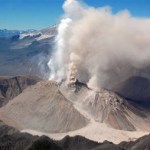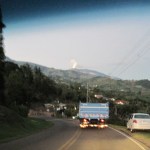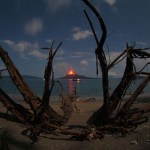volcanoes and the economy
The rhyolite domes of Chaiten in Chile in an undated photo. Note how much of the previous Chaiten Caldera has already been filled by the new domes that started after Chaiten erupted in May 2008.
CNN International has a report that the National Emergency Office (ONEMI) in Chile has reinforced the "red alert" status of Chaiten (spanish). The volcano, which has been erupting since May 2008, had recently settled down to slow, but constant, dome growth. However, over the last 3 weeks, seismicity has been increasing at the rhyolite caldera, suggesting that we might be heading towards an upswing of…
Shiveluch in Kamchatka in an undated photo.
Just a quick note, but I got this email overnight regarding the status of KVERT, the Kamchatka-Kuril Island volcano monitoring body in Russia.
Scientists of KVERT Project return to the full KVERT operations (the
information ensuring of air services for the results of daily analysis
and evaluation of activity of Kamchatka and Northern Kuriles
volcanoes) and will discharge these obligations for 01 February - 30
April 2010.
So, after losing their funding, it has some back until the end of April (based on how I read this). Russian politics as usual?…
First off, I wanted to thank all of the Eruptions readers for making January the most popular month ever on this blog. I suppose I should give an assist to Yellowstone, but really, thanks for coming to the blog, reading the posts and engaging in all the great discussions that go on within its (cyber)walls.
KÄ«lauea's east rift zone eruption site. Image courtesy of the USGS/HVO.
On to some news!
I suppose you've made the big time when you're in the New York Times, and sure enough, the current Yellowstone earthquake swarm is in the Old Grey Lady. Nothing much new to read, but summarizes the…
Bezymianny in Kamchatka, one of the many volcanoes in eastern Russia that will no longer be monitored by KVERT.
In some bad news for volcano watchers (and the general public, too), Russia has decided to stop funding KVERT (the Russian equivalent of the Alaska Volcano Observatory), the institute that monitors and researches volcanic eruptions on the Kamchatka Peninsula and the Kuril Islands in the western Pacific. Here is the news release from KVERT:
Due to a loss of government funding beginning February 01, 2010, KVERT will no longer
distribute information regarding volcanic activity in…
The steam plume from Turrialba on December 26, 2009. Image by Eruptions reader Sahrye Cohen.
Turrialba
Costa Rican officials extended the evacuation zone around Turrialba from 3 to 6 km, raising the alert status at the volcano to Yellow. Vanessa Rosales of the National Emergency Commission described the seismicity as "intense but low," but says the country is prepared to deal with the emergency. As always, the news chooses oddly what is the "news" of an event, and many article on Turrialba focus on Costa Rica's coffee - yes, it is safe, so far. A news report from the Tico Times quotes Raul…
Gambling and volcanoes go hand-in-hand?
Somehow I didn't pick up on this, but people are gambling on volcanoes now?
I mean, I suppose if they bet on the coin toss at the Super Bowl, people will bet on anything. Now, I'm not one to judge the taste in any of this, but here are the current odds for volcanoes to have a VEI 3 eruption:
3/1 Mt Unzen (Japan)
9/1 Mauna Loa (USA)
10/1 Ulawun (Papua New Guinea)
10/1 Merapi (Indonesia)
10/1 Santorini (Greece)
11/1 Colima (Mexico)
11/1 Rainier (USA)
11/1 Taal (Philippines)
11/1 Teide (Spain, Canary Islands)
12/1 Mt Nyiragongo (DR Congo)
12/1…
Lava flows from Mayon, taken December 23, 2009.
Volcano news over the holidays this year is still focused on Mayon in the Philippines. We're reaching almost a month since the volcano starting showing signs of a major eruption, but no "big one" yet. Lava flows, ash and block-and-ash flows are continuing to be issued from the new dome at the summit, but earthquakes are down some - which is leading to the problem that people are thinking the volcano is "safe". Many evacuees are returning home already, even with the threat-level at Mayon is unchanged.
This danger of people losing faith/not…
Back from Iowa, time for some volcano news. Look for the answers to your questions for Dr. Boris Behncke to get posted later this week.
(And thanks for all the comments and kind words in the Open Thread. I'll start thinking about how to implement a lot of these in the next few weeks).
Undated photo of Volcan Galeras in Colombia.
Galeras stopped traffic near Pasto, Colombia and prompted the evacuation of 1,000 people over the weekend when it erupted. The volcano apparently produced ash that covered towns near the volcano, including Pashto, and the highway connected that town with Pasto was…
Some brief tidbits for your Wednesday:
The view of Mt. Saint Helens from the Johnston Ridge Observatory.
There is a decent article about research being done at a dissected caldera system in the Italian Alps' Sesia Valley. The caldera in question is the Permian in age (248-298 million years old) so don't expect to find it in the GVP database, but the outcrops of this ancient caldera are especially well exposed, allowing for a cross section of volcano and plutonic rocks across 25 km of crustal depth (all of which is now at the surface thanks to hundreds of millions years of tectonics). It…
There are a couple article out today concerning volcanoes and the economy, one on the plus side, one on the minus side.
Volcano Buono in Italy near Naples.
First off, nothing like volcanism to get me stoked for buying stuff, eh? Actually, I have to admit, the Volcano Buono mall (yes, mall) in Italy near Naples (and yes, near Vesuvius) is one of the rather more attractive malls I've seen in a long time (above). It is designed to look like a volcano - I suppose it looks most like a monogenetic scoria cone, a little out of place for that part of Italy - but its design was based on trying use…
Some brief notes before I dive headlong into the exciting world of faculty orientation!
A small steam plume coming from Turrialba in Costa Rica. Photo taken in August 2007.
There are some preliminary reports of the state of wildlife (and everything) around Kasatochi Island in the Aleutians from the US F&W and USGS team that headed to check out how the island has recovered since last year's eruption. The shoreline has been radically transformed by the ash and although some seabirds have made attempts to nest in the loose ash, it doesn't seem to have been very successful. However, not…
I knew that the minute I said I'd be back to a "regular" posting schedule that I would fail miserably, so maybe the less said, the better.
Cerro Galan caldera in Argentina (taken from space).
Thanks to all the readers who have been avidly discussing a number of fascinating topics over the weekend.
I have seen/read a little bit about the tectonic-forcing mechanism idea for some caldera-style eruptions. The biggest thing to keep in mind is that the caldera-forming event - that is to say the collapse of the roof into the chamber - isn't usually the "trigger" as much as a result of a large…
The Royal Gardens subdivision in Hawai'i being inundated with lava flows during a 1983 eruption of Kilauea. Image courtesy of the USGS.
The game of insurance is everywhere in the news these days so it isn't too surprising to run across this brief article about the perils of getting insured if you live on an active volcano. Many people who live on the big island of Hawai'i face this challenge because a large swaths of the island fall into what is called a "Lava Zone 1", which more or less means that you live someplace that lava is likely to visit in the foreseeable future. Considering that…
Again, sorry about the paucity of posts. Getting prepared to move 3/4 of the way across a continent will do that. Look for the next Volcano Profile, this time for Erebus in Antarctica, to be posted sometime in the next week or so.
We did get some news over the weekend of a large eruption at Shiveluch. The volcano in Kamchatka has been active all summer, but on Saturday it produced a 5,000 meter / ~23,000 foot ash plume. This was accompanied by 170 earthquakes and multiple avalanches, likely produced by the collapsing dome on the summit of the volcano. There is a little more information about…
Some of the articles you might have missed this week ...
A lava flow from Kilauea breaks local traffic laws in the Royal Gardens subdivision, Hawai'i
The Mayon Watch continues in the Philippines. No eruption yet, but some of the local newspapers are printing stories talking about "odd animal behavior" and other local "myths" about predicting the volcano, such as the wells drying up. Now, this is not to say that these things might have some predictive value (especially changes in the water table near the volcano as it inflates/deflates), but so far there are no robust scientific studies that…
Anak Krakatau erupting as seen from Rataka Island. Image taken by Marco Fulle of Stromboli Online.
I frequent the Astronomy Picture of the Day website run by NASA on a daily basis. Yet somehow today I didn't check the site until well into the evening and was greeted by one of the best astronomy-volcano images I've seen in a while. Marco Fulle of Stromboli Online captured this image of Anak Krakatau erupting (in 2008 or 2009 ... its unclear in the caption) with Ursa Major rising over the volcano. There have been quite a few volcano-related images on APOD, but alas, they don't have a "volcano…
Mayon erupting in August 2004.
The increasing unrest at Mayon in the Philippines has prompted National Disaster Coordinating Council (NDCC) to recommend the evacuation of over 75,000 people from around the volcano. This, however, will only happen if the activity at the volcano continues to increase. The volcano currently sits at Alert Level 2 (increasing unrest) and if it were to increase to Level 3 (increased tendency towards eruption), then the evacuations of the first ~1,800 families closest to the volcano would begin. Only if the volcano reached Alert Level 4 (hazardous eruption imminent…
The Q&A post will be coming over the weekend (there's still time to send me a question!)
Icy cold volcanoes (well, geysers) on Enceladus, a moon of Saturn.
In the meantime, here are a few quick hits:
Mt. Cleveland in the Aleutians had a small eruption. The plume was only ~15,000 feet / ~3 km. Cleveland is one of the more active volcanoes in the Aleutians, so this eruption is not out of the norm.
Landslides and rockfalls at Arenal (in spanish) in Costa Rica continue to prompt evacuations of tourists near the volcano. It is interesting to note that officials don't seem worried about hotel…
A few quick news bits ... and thanks for the questions so far. Keep 'em coming!
Tungurahua, Ecuador erupting in 2006.
Ash fall from Tungurahua (in spanish) in Ecuador is affecting the farm towns around the volcano. Farmers in Manzano, a village nearby, fear the ash is significant enough to damage their crops. The volcano itself is throwing incandescent bombs near the vent along with producing copious ash.
There is a nice piece in the News Tribune about how Alaska Airlines handled the eruption of Mt. Redoubt near Anchorage this March. It is nice to get some insight into how airlines deal…
Some volcano news before the weekend:
The Barujari vent at Mt. Rinjani erupting in May 2009.
Barujari, the small basaltic volcano located in the crater at Mt. Rinjani, is "spewing 200-meter-high lava", at least according to recent reports. It is unclear if the eruption is, in fact, a fountain or merely strombolian activity throwing incandescent blocks that high (see above). My guess is that it is the latter, as that is much more typical for Barujari. Another report mentions a 600 meter "river of lava" (in spanish) that ends at Segara Anak lake. The volcano has been erupting all spring with…


